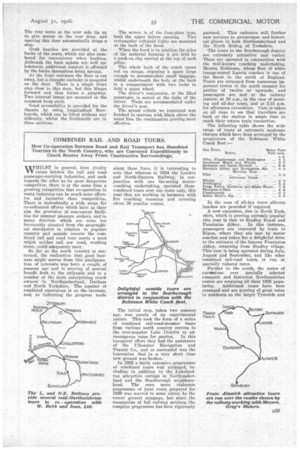PASSENGER TRAVEL NEWS.
Page 56

Page 57

If you've noticed an error in this article please click here to report it so we can fix it.
The Latest Doings and Developments in the
Bus and Coach World.
A NEW ALL-WEATHER COACH.
Built for 22 Passengers, this Beadle Body on a De Dion-Bouton Chassis Includes Many Interesting Features.
ONE of the best known of the many coachbuilders catering for commercial requirements is John C. Beadle, Ltd., whose Arorks are at Spital Street, Dartford. They have recently constructed a batch of bodies on Be DionBouton chassis, these bodies being of the all-weather class with patented head fittings of a simple but unusual type. The ideas embodied appear to us to be very serviceable and just what is required, for the body can be so constructed that when the hood is folded it is entirely concealed between the back panel and the rearmost seat, although the vehicles which have been delivered so far have had the hood made in accordance with the 22-seater which we illustrate, but even when not concealed the folded material and hoopsticks take up very little room and are inconspicuous.
The principles of the construction are extremely simple. The side.frames form an integral portion of the coachwork, but support two channels upon which the flexible hood is carried. Six plateglass windows are fitted at each side. These are controlled by rotary lifts and can be raised or lowered whether the hood he up or down. The windows run in felt-lined channels and the lifts are known as the Q.T.
Each of the hood sticks ends in a brouse ball, and the channels are really tubes slotted for their whole length and mounted along the top of the cant rail. The slot is wide enough to allow movement of the neck of each ball, but the ball cannot be lifted out of the channel, it being entered at the end mill: A neat and novel locking device is employed for keeping the ball ends of the hood sticks in position.
Mounted at the inner side of each end of the sticks is a bracket extending downwards and curved over the inner half of the tubular channel. A small space is allowed between the channel and bracket, and in this space is carried a small piece of metal shaped like a crescent moon, this being drilled at its centre to accommodate the spigot end of a setscrew, which is carried by the bracket and is provided with a wing head. The arrangement can easily be understood by referring to the sketches which we reproduce. It will be seen that by tightening the setscrew the crescent-shaped wedge piece is forced against the channel and draws the ball into intimate contact with its inner side, thus locking it securely.
So easy is the operation of raising or lowering this hood, as only light hoop sticks and the material have to be moved and their weight is always carried by the channel, that it can easily be effeetPd by one man, and this from the interior of the coach, even while the vehicle is in motion. This is a great advantage, as the speed with which the conversion is effected prevents the occupants from becoming soaked in the event of a sudden shower, and the attendant who performs the operation is not himself made uncomfortably damp.
This type of body is claimed to possess many advantages over the ordinory fixed saloon and apart from the fact that it can be rim closed or open according to the wishes of the passengers, it is actually much lighter in weight, totalling, in the example which we illus trate, less than 30 cwt. It is also claimed to be proof against vibration and free from drumming.
The disposition of the seats in the batch of vehicles under review has been most carefully planned. There is a wide centre gangway, which allows the passengers to leave by either of the two doors without disturbing the other occupants. All the seats are luxuriously upholstered, and, as an additional refinement, are provided with shoulder rests.
Although nominally a 20-seater coach, there is actually ample accommodation for 22 p:Issenzers exclusive of the driver.
The rear seats at the near side tip up to give access to the rear door, and opening this door automatically drops a step.
Grab hanclles are provided at the backs of the seats, which are also numbered for convenience when booking. Although the back sqtlales are well upholstered, additional comfort is afforded by the backs themselves being sprung.
At the front entrance the floor is cut away, but a draught excluder is mounted on the door. There is a single front step close to this door, but this hinges forward and thus forms a gangway. Two internal lamps are mounted on the reatmost hoop stick. , Good accessibility is provided for the ehassis by using longitudinal floorboards, which can be lifted without any difficulty, whilst the footboards are in three sections. The screen is of the four-piece type, both the upper halves opening. Two rettaugular celluloid lights are mounted at the back of the hood.
"When the hood is in position the sides of the material forming it are held by a push-on clip carried at the top of each pillar.
The whole hack of the coach opens out on straps, exposing a space large enough to accommodate small baggage, whilst underneath the body at the hack is a compartment with two locks to hold a spare wheel.
The driver's companion, or the 22nd passenger, is seated at the right of the driver. Tools are accommodated under the driver's seat.
The actual vehicle we examined was finished in maroon with black above the waist lino, the combination proving most effective.




































































































